Over the course of the Barn Owl breeding season and the several hundred sites that we visit across the country, we encounter and have the opportunity to engage with many landowners. There are few experiences more magical than seeing a Barn Owl, and engaging with landowners in this way is a catalyst to discuss conservation issues which affect Barn Owls and to encourage positive changes. We have seen the attitudes of many change when confronted with ‘their’ owls, and Barn Owls are one of the best ambassadors for conservation in this regard.
 Minister Noonan and Hannah Hamilton observe one of the Barn Owl chicks from the nest box at Riverfield being ringed (under licence) by John Lusby. © Peter Cutler
Minister Noonan and Hannah Hamilton observe one of the Barn Owl chicks from the nest box at Riverfield being ringed (under licence) by John Lusby. © Peter Cutler
It is not only landowners that we have the opportunity to engage with as part of this work. We were delighted that Minister for State for Housing, Local Government and Heritage, Malcolm Noonan TD joined us on our annual visit to one of Ireland’s most special Barn Owl nest sites, at Riverfield Co. Kilkenny, along with Hannah Hamilton, whose family owns Riverfield, and Dearbhala Ledwidge, the Kilkenny County Council Heritage Officer. We are currently undertaking a survey of Barn Owls in Kilkenny, which is in partnership with Kilkenny County Council and the Kilkenny Branch of BirdWatch Ireland and supported through the National Biodiversity Action Plan Fund through the Department of Housing Local Government and Heritage. We were privileged to have the Minister accompany us and witness first-hand the Barn Owl conservation work which is supported by his Department. We are sure the Barn Owls made a lasting impression, and it was a pleasure to have such an informed discussion on Barn Owls and biodiversity generally.
 Minister Noonan at Riverfield, with the Barn Owl nest box in the background.© Peter Cutler
Minister Noonan at Riverfield, with the Barn Owl nest box in the background.© Peter Cutler
The Barn Owl is a Red-listed Bird of Conservation Concern in Ireland, due to extensive declines in their breeding population and range. As a top predator and sentinel species for the health of our countryside, the declines in Barn Owl populations are extremely worrying. These declines reflect land use changes and the intensification of farming practices. Alongside these land use changes and the loss of habitat, the increased use and increased toxicity of anti-coagulant rodenticides, and the expansion of major road networks are likely to have affected Barn Owl populations. Although Barn Owl populations have declined over recent decades, there are early indications that Barn Owl populations are recovering in certain parts of their range in Ireland. This seems to be the case in Kilkenny and so the survey this season is timely, to help figure out the scale of this recovery and what is influencing the increase in the local population.
 A Barn Owl delivering a Brown Rat to the nest site, although Barn Owls can help to control rodent numbers they can also be affected by rodenticides through secondary poisoning if they feed on small mammals which have been contaminated with rodenticides.© Richard T Mills
A Barn Owl delivering a Brown Rat to the nest site, although Barn Owls can help to control rodent numbers they can also be affected by rodenticides through secondary poisoning if they feed on small mammals which have been contaminated with rodenticides.© Richard T Mills
The current Barn Owl survey in Kilkenny is focused on understanding the health of Barn Owl population in the county and to inform their conservation requirements. Thanks to the efforts of the surveyor, Mick Wright, the Kilkenny Branch of BirdWatch Ireland (particularly Pat and Mary Durkin and Ian McCullagh) and many others throughout the county, the response to the survey has been phenomenal. When we started the survey in the Spring, we knew of just five Barn Owl nests in the county and now as we approach the latter stages of the breeding season, we have confirmed over 20 nest sites. Encouragingly, many of the new nest sites are within purpose-built nest boxes, which have been installed by landowners and volunteers, many of which have been taken up by Barn Owls for the first time this season. One of the benefits of the survey, is that we now know where the important breeding sites are, which helps to ensure that these nest sites are protected and remain suitable and free from disturbance. All the site locations will be provided to the Kilkenny County Council Heritage Office to ensure appropriate protection in the future, and we will also be carrying out improvements works at some of the sites after the breeding season so that they remain suitable (e.g. replacing or installing nest boxes) for future seasons. Providing or securing nest sites is a only one element of the conservation work however and we are also working with landowners and producing guidance on habitat management and rodent control to deliver benefits for Barn Owls and the ecosystems on which they depend.
Riverfield is one of the nest sites which we have known for many years, and the Barn Owls have always done well since taking up residence in the nest box on a pole in 2014. This site, on the banks of the River Nore, is managed as a nature reserve by Hannah Hamilton and her mother, and of all the wildlife that lives here, the Barn Owls are the most famous residents. There are three healthy chicks in the nest box this season, which were fitted with a ring which allows us to assess their survival and movements. These three chicks are nearly ready to leave the nest, which is positive to see given that it has been a poor breeding season for Barn Owls across the country.
 Aerial view of Riverfield. © Peter Cutler
Aerial view of Riverfield. © Peter Cutler
Although Riverfield is small, it is having a big impact (Hannah proudly announces that 18 Barn Owls have fledged from this nest box since 2014!) and shows what can be achieved when we leave space for nature. Thanks to Hannah Hamilton as always for welcoming us to Riverfield and for taking such good care of the Barn Owls, and to Dearbhala Ledwidge, the Heritage Officer for Kilkenny County Council, for joining us and for supporting the Barn Owl monitoring and conservation work in the county, and of course to Minister Malcolm Noonan for taking the time to visit one of the projects supported by through his Department.
 The Barn Owl nest box at Riverfield, from which 18 young Barn Owls have fledged since 2014. © John Lusby
The Barn Owl nest box at Riverfield, from which 18 young Barn Owls have fledged since 2014. © John Lusby

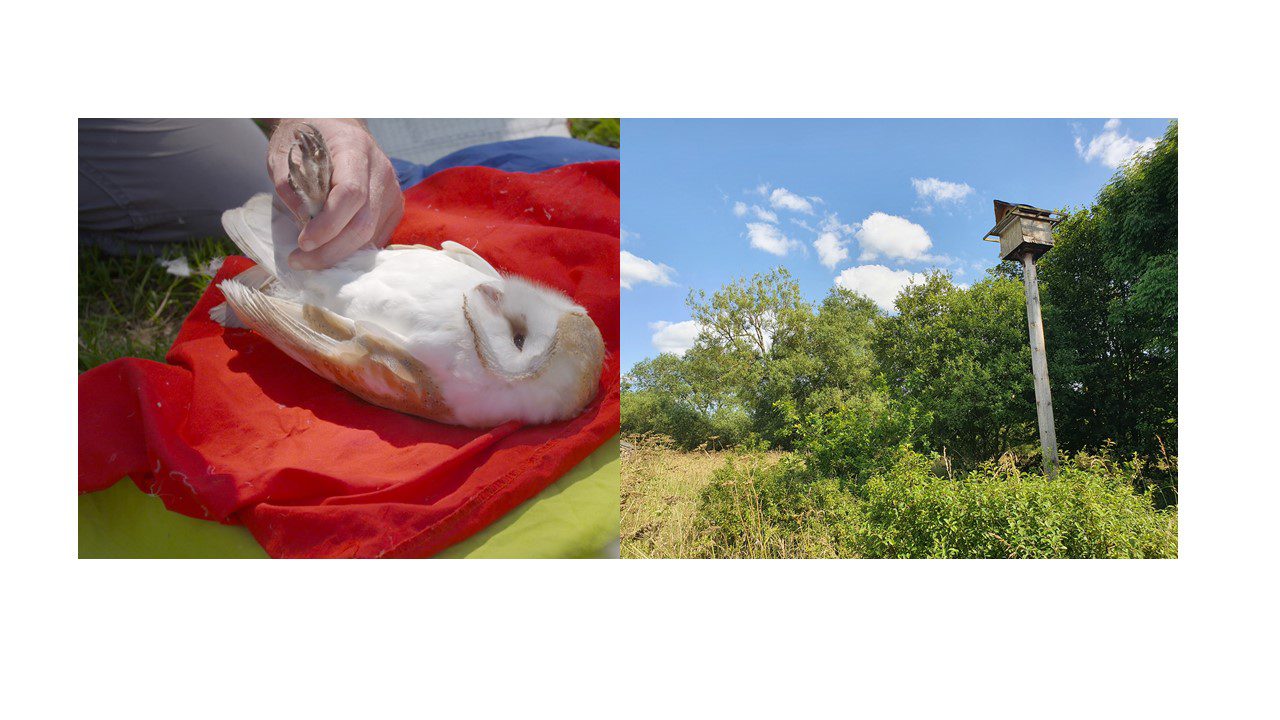
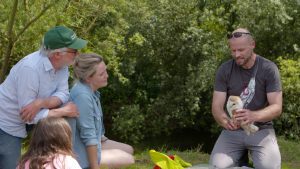 Minister Noonan and Hannah Hamilton observe one of the Barn Owl chicks from the nest box at Riverfield being ringed (under licence) by John Lusby. © Peter Cutler
Minister Noonan and Hannah Hamilton observe one of the Barn Owl chicks from the nest box at Riverfield being ringed (under licence) by John Lusby. © Peter Cutler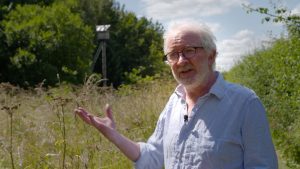 Minister Noonan at Riverfield, with the Barn Owl nest box in the background.© Peter Cutler
Minister Noonan at Riverfield, with the Barn Owl nest box in the background.© Peter Cutler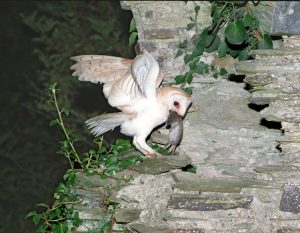 A Barn Owl delivering a Brown Rat to the nest site, although Barn Owls can help to control rodent numbers they can also be affected by rodenticides through secondary poisoning if they feed on small mammals which have been contaminated with rodenticides.© Richard T Mills
A Barn Owl delivering a Brown Rat to the nest site, although Barn Owls can help to control rodent numbers they can also be affected by rodenticides through secondary poisoning if they feed on small mammals which have been contaminated with rodenticides.© Richard T Mills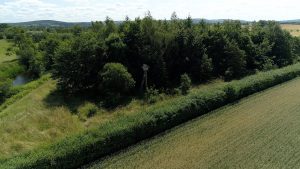 Aerial view of Riverfield. © Peter Cutler
Aerial view of Riverfield. © Peter Cutler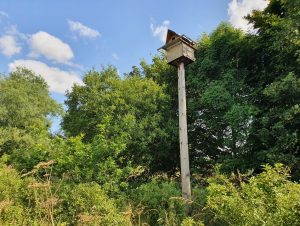 The Barn Owl nest box at Riverfield, from which 18 young Barn Owls have fledged since 2014. © John Lusby
The Barn Owl nest box at Riverfield, from which 18 young Barn Owls have fledged since 2014. © John Lusby